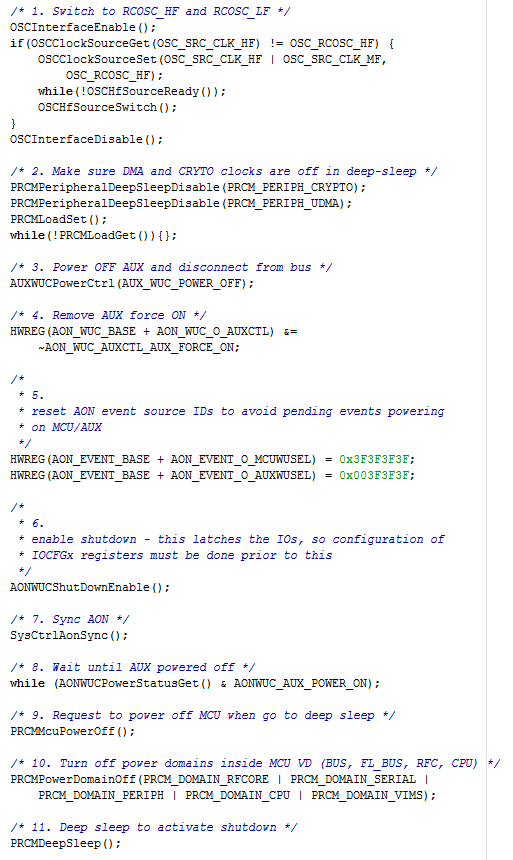SWRA486A August 2015 – April 2017 CC1310 , CC2620 , CC2630 , CC2640 , CC2640R2F-Q1 , CC2650 , CC2650MODA
- CC26x0, CC13x0 SimpleLink™ Wireless MCU Power Management Software Development
-
CC26x0, CC13x0 SimpleLink™ Wireless MCU Power Management Software Development
- 1 Abbreviations
- 2 Power Management Introduction
- 3 TI-RTOS Power Modes
- 4 Implementation Considerations
- 5 References
- Revision History
3.4 Shutdown Mode
In shutdown mode, the CC26x0 and CC13x0 devices shut off except for the input and output pins. The device can wake up on any input pin (configured through the IOCFGn registers). The system completely reboots when waking up from shutdown. You can call SysCtrlResetSourceGet() to detect that the device is booting from shutdown. For details on the TI-RTOS implementation of entering shutdown, see Figure 7.
 Figure 7. Shutdown Enter Sequence
Figure 7. Shutdown Enter Sequence - Switch to RCOSC_HF and RCOSC_LF— high-speed RC oscillator.
- Make sure DMA and CRYTO clocks are off before entering shutdown
- Power OFF AUX and disconnect from bus— Configure the auxiliary domain.
- Remove AUX force ON— Request to power off the auxiliary domain.
- Reset AON event source IDs to avoid pending events powering on MCU/AUX— Ensure no events from AON prevent the device from entering shutdown.
- Enable shutdown – this latches the IOs, so configuration of IOCFGx registers must be done prior to this— Configure shutdown mode. Because this function also latches the inputs and outputs, configure any input and output (such as configuring which inputs and outputs to wake up on) before executing this function.
- Sync AON— Ensure AON configurations take effect.
- Wait until AUX powered off— Ensure the auxiliary domain is off.
- Request to power off MCU when go to deep sleep— Request to power off the MCU voltage domain when Cortex-M3 enters deep-sleep mode.
- Turn off power domains inside MCU VD (BUS, FL_BUS, RFC, CPU)— Turn off power domains inside the MCU voltage domain.
- Deep sleep to activate shutdown— Enter deep-sleep mode by executing WFI instruction. WFI instruction shuts down the system. Because the Cortex-M3 reboots when waking up, no instructions execute after the PRCMDeepSleep() function.
When waking up from a shutdown, the device reboots. The input and output state is retained through shutdown to avoid glitches. Software using the shutdown-power mode calls SysCtrlResetSourceGet() early in the application to check the wake-up source. If the device wakes up from a shutdown, the application restores the configuration of the input and output registers before opening to latches to avoid glitches. Write 1 to AON_SYSCTL:SLEEPCTL[0] to unlatch the inputs and outputs.